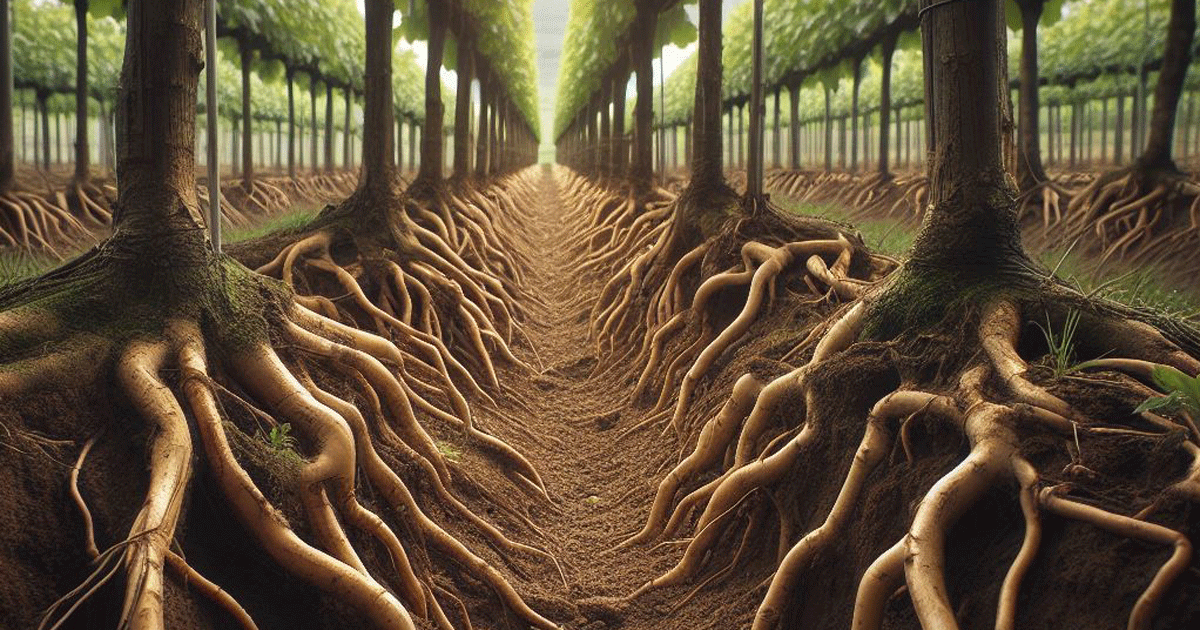Rootstocks represent a pivotal yet often enigmatic facet of the wine industry. Despite their prominence in discussions, own rootstocks are commonly viewed as supreme.
Rootstocks are hybrids with the genetic heritage of American Vitis species and serve as the root system onto which the fruiting vine of any desired variety can be grafted. The grafting process involves a precise omega cut to remove the top half, followed by the grafting of a Vitis Vinifera scion, encompassing iconic varieties like Sauvignon Blanc, Chardonnay, Malbec, and Pinot Noir. This amalgamation yields two distinct species, allowing for intriguing possibilities, including my own home trials that have seen the fusion of two distinct genus plants, such as one trunk bearing four different chili varieties. This diversity extends beyond the boundaries of winemaking.
Grafted rootstocks wield the potential to significantly enhance both quality and yield, thereby translating into tangible commercial advantages. These versatile plants can be harnessed to cultivate balanced vines, fend off pests and diseases, and combat the relentless specter of drought. Moreover, they can exert influence over grape maturation, either accelerating or postponing it, ultimately impacting the volume of the harvest. An exemplary case in point is SO4, which advances maturity by 1-2 weeks. This temporal divergence can prove invaluable in ensuring that not all grapes reach phenolic ripeness simultaneously. In the realm of viticulture, where economics looms large, such nuances assume paramount importance.
On the other hand, own rootstocks can tolerate saline soils, as commonly found in Chile. Being isolated by the Andes and phylloxera-free, winemakers choosing ungrafted vines miss out on an option to adapt the vine better to its terroir. Saline soils contribute to a smaller harvest crop. If the salinity is too high, the vine dries out, requiring the water-intensive leaching method, which might not be the most sustainable approach in the future. However, it enables them to use their own cuttings or vines through layering, retaining their genetic pool in the vineyard..

How Rootstocks influence Grape-Quality
In pursuit of high-quality grapes, viticulturists strive to nurture balanced vines. Such vines strike an equilibrium between vigor, crop yield, and economic viability. Achieving this equilibrium hinges on thorough climate and soil analysis, highlighting crucial factors such as drought resistance, water holding capacity (WHC), pH levels, and nutrient availability. However, empirical tests, such as the one featuring the rootstock 5C Teleki and Chardonnay conducted by the Australian viticulturist Nick Dry, reveal that grafted vines can yield 10 kg more per vine while maintaining consistent quality compared to ungrafted counterparts. This highlights the pivotal role of rootstock selection in shaping grape quality.
In regions with limited water resources, rootstocks adapted for drought resistance, typified by V. Rupestris varieties like 110 Richter, become indispensable for enabling viticulture. Planting a high-vigor rootstock like SO4 in such environments, with its elevated water requirements, would result in leaf wilting, vine shutdown, and eventual demise.
Rootstocks also emerge as valuable assets in integrated pest management (IPM) and organic viticulture. Nematodes, microscopic worms that can proliferate rapidly, pose a severe threat to vines, with the dagger nematode being a common antagonist. This nematode not only feeds on rootstocks as some also serve as a vector for the Fanleaf virus, which causes small and uneven developed berries in short clusters. Here, rootstock selection can be instrumental in pest mitigation.
Ultimately, pragmatism emerges as the guiding principle in rootstock choices. A seasoned viticulturist’s counsel rings true: “Ask what they have and order at least 3 years in advance.” This sage advice acknowledges the possibility of nurseries relabeling vines, emphasizing the importance of proactive planning and research.
Challenging the Ungrafted Vines
While some venerable vines continue to flourish on their own roots, their success often results from careful pruning decisions and effective management, rather than solely relying on the fact that they are ungrafted. However, not being grafted does offer a higher frost resistance of the trunk, reducing the labor costs of layering protective soil around the graft.
One of the most famous examples is ‘Hills of Grace,’ owned by Henschke, which was planted in the mid-19th century. Despite its fame and age, one may question whether these pre-phylloxera vines survive solely because they are ungrafted. A fascinating experiment in Priorat involved removing the scion, pulling up a watershoot of the American Vitis, and allowing the rootstock to grow leaves and store carbohydrates. After its rejuvenation, it underwent field grafting with its own Garnacha cutting, preserving the ancient root system while fostering a young scion that bears fruit.
This raises intriguing questions about the definition of an ‘old vine,’ a topic ripe for exploration in future discourse. Since ungrafted vines are mythical and commonly found in the premium to high-premium section and can potentially develop into old vines, the mass-produced wines on the shelf are calculated to require the benefits of the rootstock to remain a long-term feasible solution.
Did you like the Article?
Did you find this article helpful? Please share it. If you’d like to discuss it further, don’t hesitate to reach out. If you’re in search of an educator for your masterclass or brand presentation, feel free to check in with us, and we can schedule a call.
Disclaimer
This text was neither commissioned nor compensated. It reflects exclusively my own opinion.

ConVINOsation Podcast Brings EUROVINO Wine Fair to Life
In collaboration with Messe Karlsruhe, we are proud to launch ConVINOsation, a new podcast dedicated to tackling the wine industry’s most pressing topics. Hosted by

Live on Wein Verkauft!
I recently had the opportunity to join freelance consultant Diego Weber from Germany on his podcast, On German!. Over the course of the two-hour episode,

Live on the Morning Show
In July 2024, I had the exciting opportunity to appear on New York’s WTBQ Frank Truatt’s Morning Show, the #1 drive time morning show, with
Challenging Year for French Wines & Spirits Exports 2023
In the year 2023, the French wine and spirits sector navigated through challenging waters to post exports worth €16.2 billion. Despite representing a 5.9% decline from the previous year, this figure stands as the second-highest in the industry’s export history. The volume of exports also saw a considerable reduction, falling by 10.4%. However, the sector managed to maintain its status as the leading contributor to France’s agri-food surplus and the third largest in the nation’s overall trade balance, with a trade surplus of €14.8 billion, down by 5.8%.

DWI Announces Winner of the Sommelier Cup 2024
The DWI Sommelier-Cup 2024, hosted by the German Wine Institute (DWI), concluded on January 22, 2024, with Katharina Iglesias from wineBank in Hamburg claiming the title. The event, held at the Atrium Hotel in Mainz, witnessed participation from 28 professionals across various sectors of the wine industry. While the competition’s popularity remains undeniable, a critical examination of its structure and outcomes reveals aspects worth contemplating.

German Wine Consumption Plummets in 2023
The German wine consumption and buying behaviour is changing. (Photo: DallE)
